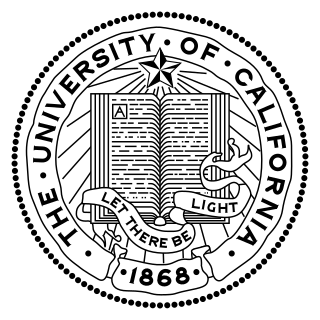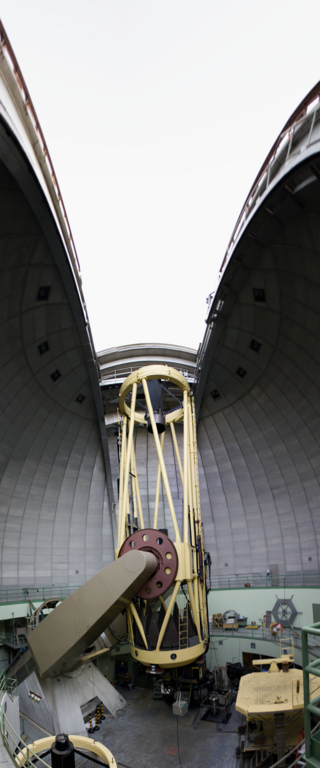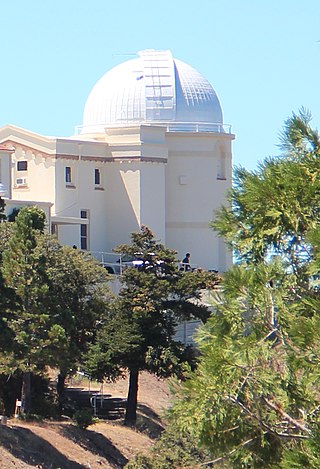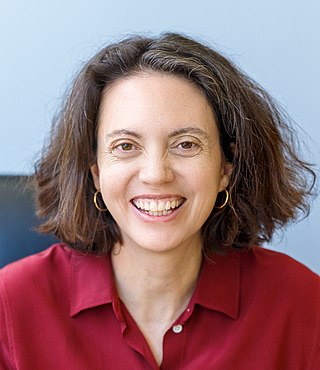Related Research Articles

The University of California (UC) is a public land-grant research university system in the U.S. state of California. Headquartered in Oakland, the system is composed of its ten campuses at Berkeley, Davis, Irvine, Los Angeles, Merced, Riverside, San Diego, San Francisco, Santa Barbara, and Santa Cruz, along with numerous research centers and academic centers abroad. The system is the state's land-grant university.

Sandra Moore Faber is an American astrophysicist known for her research on the evolution of galaxies. She is the University Professor of Astronomy and Astrophysics at the University of California, Santa Cruz, and works at the Lick Observatory. She has made discoveries linking the brightness of galaxies to the speed of stars within them and was the co-discoverer of the Faber–Jackson relation. Faber was also instrumental in designing the Keck telescopes in Hawaii.

The W. M. Keck Observatory is an astronomical observatory with two telescopes at an elevation of 4,145 meters (13,600 ft) near the summit of Mauna Kea in the U.S. state of Hawaii. Both telescopes have 10 m (33 ft) aperture primary mirrors, and, when completed in 1993 and 1996, they were the largest optical reflecting telescopes in the world. They have been the third and fourth largest since 2006.

The Lick Observatory is an astronomical observatory owned and operated by the University of California. It is on the summit of Mount Hamilton, in the Diablo Range just east of San Jose, California, United States. The observatory is managed by the University of California Observatories, with headquarters on the University of California, Santa Cruz campus, where its scientific staff moved in the mid-1960s. It is named after James Lick.

Heber Doust Curtis was an American astronomer. He participated in 11 expeditions for the study of solar eclipses, and, as an advocate and theorist that additional galaxies existed outside of the Milky Way, was involved in the 1920 Shapley–Curtis Debate concerning the size and galactic structure of the universe.
Leuschner Observatory, originally called the Students' Observatory, is an observatory jointly operated by the University of California, Berkeley and San Francisco State University. The observatory was built in 1886 on the Berkeley campus. For many years, it was directed by Armin Otto Leuschner, for whom the observatory was renamed in 1951. In 1965, it was relocated to its present home in Lafayette, California, approximately 10 miles (16 km) east of the Berkeley campus. In 2012, the physics and astronomy department of San Francisco State University became a partner.

The James Lick Telescope is a refracting telescope built in 1888. It has a lens, which is 91 centimetres (36 in) in diameter—a major achievement in its day. The instrument remains in operation and public viewing is allowed on a limited basis. Also called the "Great Lick Refractor" or simply "Lick Refractor", it was the largest refracting telescope in the world until 1897, and now ranks third, after the 40-inch refractor at the Yerkes Observatory and the Swedish 1-m Solar Telescope. The telescope is located at the University of California's Lick Observatory atop Mount Hamilton at an elevation of 1,283 metres (4,209 ft) above sea level. The instrument is housed inside a dome that is powered by hydraulic systems that raise and lower the floor, rotate the dome and drive the clock mechanism to track the Earth's rotation. The original hydraulic arrangement still operates today, with the exception that the original wind-powered pumps that once filled the reservoirs have been replaced with electric pumps. James Lick is entombed below the floor of the observing room of the telescope.

The C. Donald Shane telescope is a 120-inch (3.05-meter) reflecting telescope located at the Lick Observatory in San Jose, California. It was named after astronomer C. Donald Shane in 1978, who led the effort to acquire the necessary funds from the California Legislature, and who then oversaw the telescope's construction. It is the largest and most powerful telescope at the Lick Observatory, and was the second-largest optical telescope in the world when it was commissioned in 1959.

The Anna L. Nickel telescope is a 1-meter reflecting telescope located at Lick Observatory in the U.S. state of California.

The Automated Planet Finder (APF) Telescope a.k.a. Rocky Planet Finder, is a fully robotic 2.4-meter optical telescope at Lick Observatory, situated on the summit of Mount Hamilton, east of San Jose, California, USA. It is designed to search for extrasolar planets in the range of five to twenty times the mass of the Earth. The instrument will examine about 10 stars per night. Over the span of a decade, the telescope is expected to study 1,000 nearby stars for planets. Its estimated cost was $10 million. The total cost-to-completion of the APF project was $12.37 million. First light was originally scheduled for 2006, but delays in the construction of the major components of the telescope pushed this back to August 2013. It was commissioned in August 2013.

The Nasmyth telescope, also called Nasmyth–Cassegrain or Cassegrain–Nasmyth, is a reflecting telescope developed by the Scottish inventor James Nasmyth. It is a modified form of a Cassegrain telescope, with light reflected sideways to an eyepiece.

Claire Ellen Max is a Professor of Astronomy and Astrophysics at the University of California, Santa Cruz (UCSC) and is affiliated with the Lick Observatory. She was the Director of the Center for Adaptive Optics at UCSC, 2007-2014. Max received the E.O. Lawrence Award in Physics.
Jerry Earl Nelson was an American astronomer known for his pioneering work designing segmented mirror telescopes, which led to him sharing the 2010 Kavli Prize for Astrophysics.
Steven Scott Vogt is an American astronomer of German descent whose main interest is the search for exoplanets.
The Lick–Carnegie Exoplanet Survey (LCES) is a search for exoplanets using the Keck I optical telescope of the W. M. Keck Observatory in Hawaii. The survey is sponsored by NASA and the National Science Foundation. The survey comprises a decade of observations. The survey is led by Steven Vogt, professor of astronomy and astrophysics at University of California at Santa Cruz, and R. Paul Butler of the Carnegie Institution.
Harland Epps is an astronomer, known for designing effective optics for telescopes all around the world. He is also a professor at the University of California Observatories (UCO) / Lick Observatory, teaching astronomy and astrophysics.
Constance "Connie" Mary Rockosi is a professor and former department chair in the Astronomy and Astrophysics Department at the University of California, Santa Cruz. She earned her PhD in 2001 and helped design the camera for the telescope that was used as part of the initial Sloan Digital Sky Survey (SDSS). She also was in charge of the SDSS-III domain for the Sloan Extension for Galactic Understanding and Exploration (SEGUE) project and is the primary investigator on SEGUE-2. Her focuses involve the study of the Milky Way galaxy, with a focus on the evolution that it took to reach its current state.
Michael Bolte is a Distinguished Professor of Astronomy and Astrophysics at the University of California Santa Cruz. From 2005 - 2012 he was the Director of the University of California Observatories which operates Lick Observatory near San Jose California, co-manages the W.M. Keck Observatory, and leads the University of California participation in the Thirty-Meter Telescope Project. He was a member of the Board of Directors for the CARA Board that oversees the W.M. Keck Observatory from 2005 - 2013 and has been a Director on the Board of Directors for the Thirty-Meter Telescope International Observatory since 2005.

Jennifer Mae Lotz is an American astronomer who studies the shape and evolution of galaxies, including galaxy mergers. She works at the NOIRLab, a project of the National Science Foundation, as director of the Gemini Observatory.
References
- ↑ "University of California Observatories". University of California Observatories. Retrieved 2024-10-10.